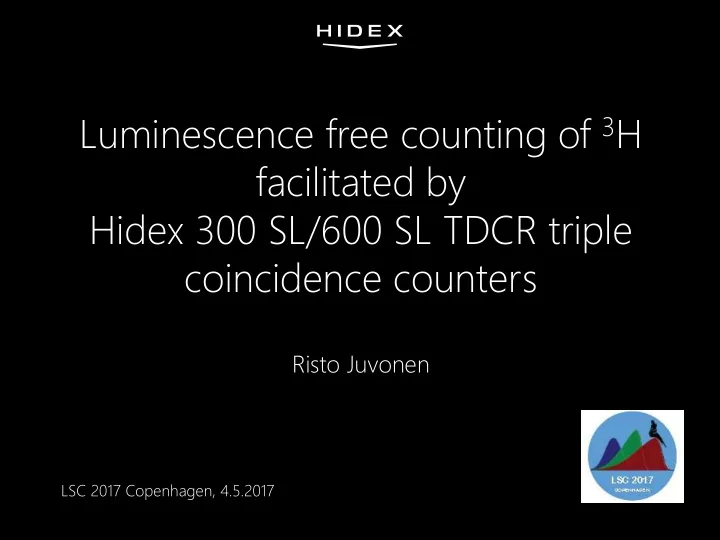

Luminescence free counting of 3 H facilitated by Hidex 300 SL/600 SL TDCR triple coincidence counters Risto Juvonen LSC 2017 Copenhagen, 4.5.2017
Hidex 300 SL and 600 SL Automatic TDCR Liquid Scintillation Counters Automatic vial counters with triple- PMT detector facilitating: Exceptionally high counting efficiency, • Absolute activity couting of beta • isotopes (H-3, C-14,.. ) and Cherenkov isotopes (Y-90, Sr-89,..) using TDCR method without external radioactive standard source Luminescence free counting mode • a/b separation with 2D graphical • calibration & validation tool
Luminescence interference Luminescence is one of the main interferences in scintillation counting Single photon event increasing the background and increases results variation Methods to reduce and correcting luminescence are (1) Dark adaptation of sample (2) Chemical methods (3) T emperature control (4) Counting region settings (5) Delayed coincidence counting Many labs are counting samples also with repeats, and removing outliers - How to find outlier? - Do I have to recount the sample or can I calculate the results using the data of remaining repeats?
Luminescence Free Counting method (LF method) for 3 H in water Method is based on counting region (ROI) settings With double coincidence counters the conventional method based on counting regions (ROIs) works relatively well for higher energy isotopes like 14 C but yields in too low counting efficiency for 3 H water samples. Improved LF method was tested for 3 H water samples and requires triple coincidence counter like Hidex 300 SL or 600 SL.
5 Triple detector array and coincidences R R S: Double Coincidence Counts R S T: Triple Coincidence Counts R T: Double Coincidence Counts S T: Double Coincidence Counts Sample S T R S T R S R T S T C t = triple counts C d = double counts C all = All coincidence counts
Luminescence do not interfere with triple counts 14 C C in 3m in 3ml l 2M 2M NaOH OH + 1 + 17 m ml l Opt ptiP iPhase Hi HiSa Safe 3 14 3 H bk bkg s g spec pectra, 8 8 ml H l H 2 O + 1 + 12 m 2 ml U l UG uL uLLT All c count unts (blue), with luminescence peak Triple riple coinc incio iode dence c e coun unts (red), no luminescence interference In Luminescence Free mode (LF mode) only Luminescence Free Counts are recorded: 1) All Triple Coincidence counts 2) Pure Double Coincidence counts at above luminescence ROI (> ch 120) Improved eff. Allows also 3 H water measurements in LF mode
Performance comparison of Lum Free mode and Normal count mode for 3 H in water Hidex 300 SL 425-020, 8 + 12 ml sample, 10 x 50 min, ka = kb = 1.645 Nor ormal mal M Mode LF Mo Mode de Bkg kg 4.7 CPM 2.8 CPM Eff ff. 37 % 24 % 2.6 Bq/L 3.1 Bq/L Ld 1.2 DPM 1.5 DPM Out Outlier liers High risk Low risk
IAEA TRIC2012 3 H Refence samples in LF mode Samp mple Hid Hidex 3 300 SL SL, LF mode TRI RIC Re Ref. l . labs TRIC T IC T op lab 8 mL + 12 mL UGuLLT, 20 x 50 min 2000 min Deuterium Spike TU ( 2 H) Unc. TU (spike) Unc. TU (known) Unc. TU (known) Unc. TR TRIC-20 20 0 0 0 0 0 0,10 0,02 0,01 TR TRIC-21 21 0,26 0,16 0,28 0,17 0,43 0,10 0,44 0,02 TRIC-22 TR 22 1,13 0,18 1,17 0,18 1,12 0,10 1,12 0,15 TRIC-23 TR 23 2,71 0,20 2,81 0,20 2,74 0,07 2,70 0,04 TR TRIC-24 24 4,25 0,11 4,45 0,21 4,37 0,13 4,45 0,06 TR TRIC-25 25 7,57 0,29 7,61 0,25 7,51 0,23 7,45 0,09 *Data provided by IAEA Hydrogeology lab, Vienna Hidex 300 SL can be used to produce accurate data on LF mode for low level 3 H water samples.
9 Quench Correction in LF mode TDCR cannot be used directly in LF mode as luminescence interferes with double coincidence counts (c d ) c c t t TDCR = = + c c c t all d Availabel methods: 1. Constant quench correction factor (preferred when quenching is constant) 2. External std curve method 3. Corection of TDCR with Chemi CPM c c t t TDCR = = − − + c Chemi c Chemi c t all d 4. Triple Coincidence Channel Ratio method - Ratio of Triple Coincidences in two different region used as quench parameter => (tROI1/tROI2) vs. Eff. HIdex Oy / Risto Juvonen
10 Summary • Luminescence do not interfere with triple coincidence counts • LF mode = all triples + pure doubles above luminescence ROI ⇒ Improved eff. allows also 3 H water measurements in LF mode • In LF mode the Eff. and Bkg are reduced, Ld only slightly higher • T otal counting time is reduced as in LF mode counting can be started more or less immediately after sample preparation • Low risk for outliers • In LF mode the preferred quench correction method is the use of Constant Quench Correction Factor (other methods are applicable) • Hidex 300 SL and 600 SL provide accurate data in LF mode for low level 3 H water samples HIdex Oy / Risto Juvonen
Thank You! Risto Juvonen Product manager risto.juvonen@hidex.com Lemminkäisenkatu 62 info@hidex.com T el. +358 10 843 5570 FI-20750 Turku www.hidex.com
Recommend
More recommend